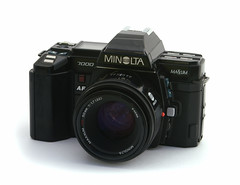Minolta 7000
The Minolta 7000 (Maxxum 7000 in North America and Alpha 7000 in Japan) was the first commercially successful, autofocus SLR camera.
Before the Minolta 7000, Nikon, Canon, Pentax and Olympus had experimented with self-contained auto-focusing lenses that worked with their existing cameras and used their existing lens mounts. Minolta burst onto the scene in 1985 with their new in-body auto-focus camera system and changed the modern SLR camera forever. In rapid succession the company released three cameras (5000, 7000 and 9000) and several lenses to make a completely new fully featured AF system. For the next couple of years Minolta autofocus film cameras dominated the market.
In addition to autofocus, the Maxxum had manual, aperture priority, shutter priority, and program modes. Knobs and dials were replaced with pushbuttons and internal and external liquid crystal displays (LCD's). Popular with many new buyers, the LCD displays were disliked by photographers used to the older controls. The new camera body utilized a large amount of plastic composites which also came in for both praise and criticism. Universally disliked was the rather slow flash sync-speed (1/100) and no multi-exposure capability.
Early Maxxum 7000 cameras were inscribed "MAXXUM 7000" with a crossed 'XX'. The oil company Exxon considered this a violation of their trademark, as the XX in their logo was linked in a similar fashion. As a result, Minolta was allowed to distribute cameras already produced, but was forced to change the stylistic XX in Maxxum and implement this as a change in new production. All Maxxum cameras to this day have had regularly scripted 'X'.
Unfortunately for Minolta, its autofocus design was found to infringe on the patents of Honeywell, a U.S. corporation. After protracted litigation, Minolta in 1991 was ordered to pay Honeywell damages, penalties, trial costs, and other expenses in a final amount of 127.6 million dollars.
When Pentax and Nikon entered the autofocus segment, both utilized a similar passive array AF system as Minolta, but decided to retain compatibility with their existing manual-focus K and F mounts respectively. Canon, like Minolta, chose to change their mount completely, introducing the EOS 600-series a few years later, breaking the compatibility with the former FL and FD lens mounts. Like Canon, Minolta's decision to orphan its manual-focus mount cost it the support of some loyal customers, but in so doing, it also gained some new customers.
References
- Article, "Minolta Credit Rating Downgraded by Moody's", July 11, 1992, NY Times
Links
- Review at Modern Classics
- Maxxum (Dynax) 7000i
- Minolta 7000 on www.collection-appareils.fr by Sylvain Halgand
| Minolta Classic Cameras |
|---|
| Vest (or Best) | V2 | SR-2 | SRT 101 | XE | XD | CLE | 7000 | 9000 | 800 si |
